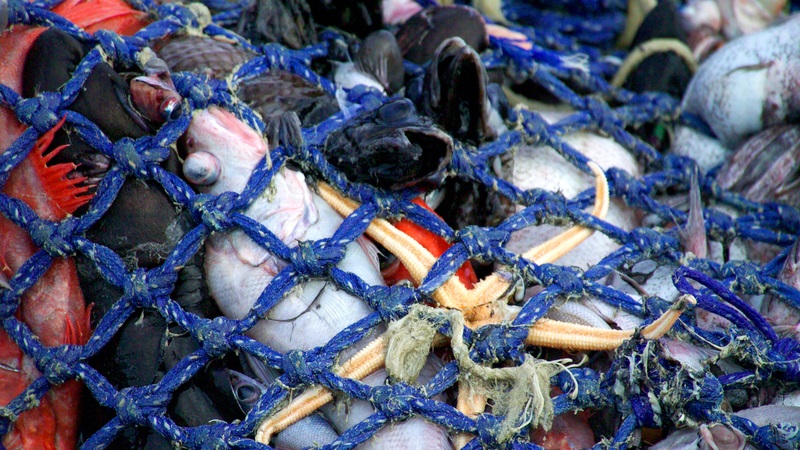EU countries will be required to reduce the harmful impacts of fishing on sensitive species and their habitats, under a draft EU biodiversity plan seen by Euractiv.
The “EU Action Plan to protect and restore marine ecosystems for sustainable and resilient fisheries” is expected to be released in the first quarter of 2023 by the European Commission.
One of its flagship measures is to halt the destructive impacts of bottom trawling, a method of fishing that involves dragging heavy weighted nets across the sea floor in an effort to catch fish.
This fishing method stirs up greenhouse gases from the seabed, much of which escapes into the water and up into the atmosphere where it contributes to cliamte change.
A 2021 study found that six European Union countries were among the ten global nations with the largest bottom-trawling emissions inside their exclusive economic zone.

Under the draft plan, bottom trawling would be banned in Marine Protected Areas (MPAs) by 2030 but would still be allowed outside of those.
Deep sea trawling at depths greater than 800 meters was already banned across the EU in 2016, albeit with some exceptions.
Industry opposition
The action plan was first mentioned in the Commission’s Biodiversity Strategy for 2030 as a way to protect nature and reverse biodiversity loss.
It was initially expected in 2021 but was delayed several times after a public consultation revealed strong opposition from the fishing industry.
Azerbaijan weaponises conservation law in conflict with Armenia
Europêche, an industry group, said in was “appalled” by the Commission’s assertion that bottom contacting fishing gear was the most damaging activity to the seabed.
The commission’s strategy said: “By its very nature, mobile bottom fishing is among the least selective fishing methods and produces disproportionate amounts of unwanted cash and discards”.
But the industry association said in a response to a public consultation: “Dragging a fishing net through the water column or along the seafloor can be unsustainable if done so irresponsibly. But with proper management and careful placement, trawling can be very sustainable”.
Still, the draft plan warns that the European fisheries sector faces “existential threats” posed by climate change and biodiversity loss. It underlines that only a healthy marine environment will guarantee a prosperous future for fisheries communities.
Africa objects to US chairing UN climate fund, citing unpaid $2bn
“Protecting and restoring Europe’s seas and oceans has become more essential than ever to counter the harmful impacts of the triple planetary crises of climate change, biodiversity loss and pollution on our economies and societies, including the fishing sector and coastal communities,” the document reads.
Protection shortfalls
As of today, only 12% of EU seas are designated as protected areas, and less than 1% are strictly protected, the document underlines.
This is way below the 30% protected, and 10% strictly protected, that the EU aims to achieve by 2030 as part of its biodiversity strategy for 2030.
The intention is also to address the shortcomings identified in the 2020 European Court of Auditors’ special report on the marine environment.
Many marine species and habitats are in poor state, the report underlined, concluding that European seas could not be considered as “healthy or clean” and that a high proportion of marine species and habitats assessments show “an unfavourable conservation status”, with fishing exerting the main pressure on marine ecosystems.
To address these issues, the action plan intends to act on four fronts:
- Improving fishing selectivity and reducing harmful impacts on sensitive species and their habitats;
- Minimising the impact of fishing – including bottom trawling – on sensitive habitats such as the seabed;
- Ensuring a fair and just transition in the fishing sector; and
- Strengthening research and innovation to integrate the concept of ‘natural capital’ in economic decisions.
NGOs respond
Conservation groups welcomed the Commission’s plan but argue that the draft falls short on several points.
“The Action Plan clearly states that we need to move away from destructive fisheries like bottom trawling, which is the first time the Commission is so clear about the problem, and we welcome this,” said Monica Verbeek, executive director of the marine conservation organisation Seas at Risk.
“The Action Plan also recognises the need for a just transition to low-impact fisheries, which we think is the only way to move out of the current failed system,” she told Euractiv in written comments.
But to achieve this, the plan relies mainly on the implementation of current environmental legislation and of the Common Fisheries Policy (CFP), which have so far “not delivered effective protection for marine species and ecosystems,” Verbeek argued.
Besides, the proposal to prohibit bottom trawling in marine protected areas (MPAs) by 2030 is a full seven years from now, NGOs point out, warning that it is counterintuitive to continue destruction until then in MPAs, which are areas in special need of protection.
“The Commission itself seems to recognise that the proposed measures will not do the trick, as they plan to assess progress in 2024 and already hint at a follow-up legislative proposal which will then conveniently be up to the next Commissioner to deal with,” Verbeek told Euractiv, referring to the fact that the Commissioner for the Environment, Oceans and Fisheries Virginijus Sinkevičius will end his term in 2024.
A version of this article was originally produced by Euractiv and republished under a content-sharing agreement.
